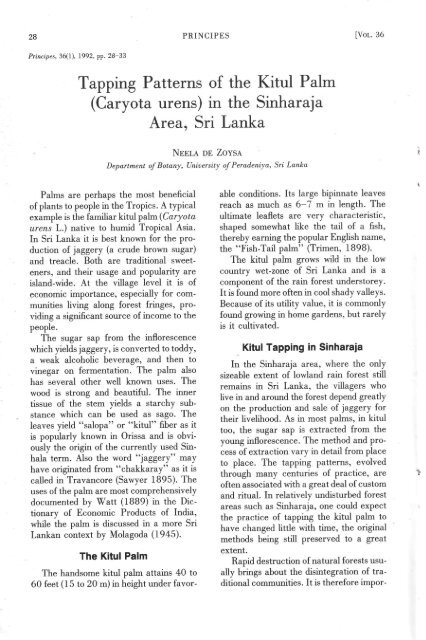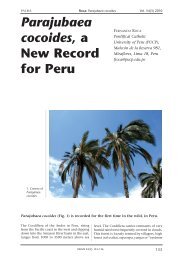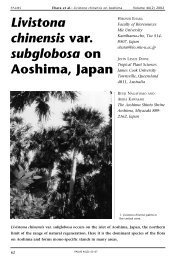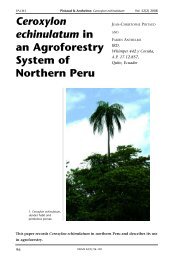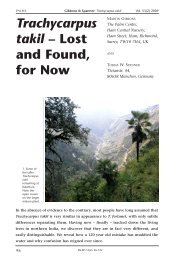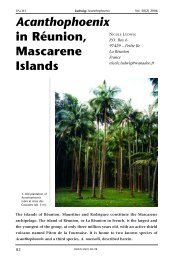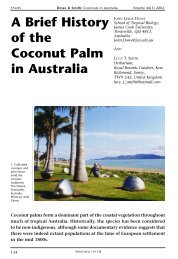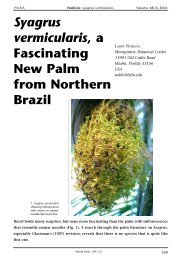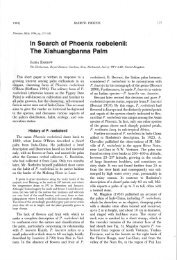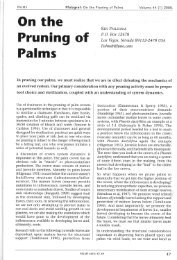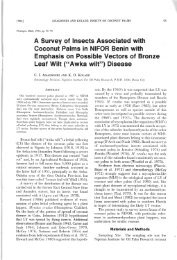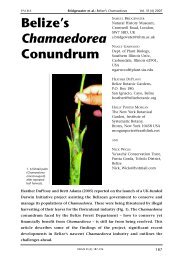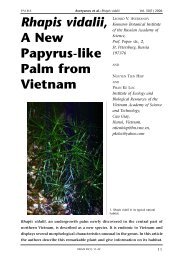Tapping Patterns of the Kitul Palm (Caryota urens) in the Sinharaja ...
Tapping Patterns of the Kitul Palm (Caryota urens) in the Sinharaja ...
Tapping Patterns of the Kitul Palm (Caryota urens) in the Sinharaja ...
You also want an ePaper? Increase the reach of your titles
YUMPU automatically turns print PDFs into web optimized ePapers that Google loves.
28<br />
Pr<strong>in</strong>cipes,36(l), 1992, pp. 28-33<br />
PRINCIPES [Vor 36<br />
<strong>Tapp<strong>in</strong>g</strong> <strong>Patterns</strong> <strong>of</strong> <strong>the</strong> <strong>Kitul</strong> <strong>Palm</strong><br />
(<strong>Caryota</strong> <strong>urens</strong>) <strong>in</strong> <strong>the</strong> S<strong>in</strong>haraja<br />
Area, Sri Lanka<br />
Noelt DE ZoYSA<br />
Department <strong>of</strong> Botany, Un<strong>in</strong>ersity <strong>of</strong> Perad'eniya, Sri Lanka<br />
<strong>Palm</strong>s are perhaps <strong>the</strong> most beneficial<br />
<strong>of</strong>plants to people <strong>in</strong> <strong>the</strong> Tropics. A typical<br />
example is <strong>the</strong> familiar kitulpalm(<strong>Caryota</strong><br />
<strong>urens</strong> L.) native to humid Tropical Asia.<br />
In Sri Lanka it is best known for <strong>the</strong> production<br />
<strong>of</strong> jaggery (a crude brown sugar)<br />
and treacle. Both are traditional sweeteners,<br />
and <strong>the</strong>ir usage and popularity are<br />
island-wide. At <strong>the</strong> village level it is <strong>of</strong><br />
economic importance, especially for communities<br />
liv<strong>in</strong>g along forest fr<strong>in</strong>ges, provid<strong>in</strong>g<br />
a significant source <strong>of</strong> <strong>in</strong>come to <strong>the</strong><br />
people.<br />
The sugar sap from <strong>the</strong> <strong>in</strong>florescence<br />
which yields j aggery,is converted to toddy,<br />
a weak alcoholic beverage, and <strong>the</strong>n to<br />
v<strong>in</strong>egar on fermentation. The palm also<br />
has several o<strong>the</strong>r well known uses. The<br />
wood is strong and beautiful. The <strong>in</strong>ner<br />
tissue <strong>of</strong> <strong>the</strong> stem yields a starchy substance<br />
which can be used as sago. The<br />
leaves yield o'salopa" or o'kitul" fiber as it<br />
is popularly known <strong>in</strong> Orissa and is obviously<br />
<strong>the</strong> orig<strong>in</strong> <strong>of</strong> <strong>the</strong> currently used S<strong>in</strong>hala<br />
term. Also <strong>the</strong> word "jaggery" ^uy<br />
have orig<strong>in</strong>ated from oochakkaray'o<br />
as it is<br />
called <strong>in</strong> Travancore (Sawyer 1895). The<br />
uses <strong>of</strong> <strong>the</strong> palm are most comprehensively<br />
documented by Watt (1889) <strong>in</strong> <strong>the</strong> Dictionary<br />
<strong>of</strong> Economic Products <strong>of</strong> India,<br />
while <strong>the</strong> palm is discussed <strong>in</strong> a more Sri<br />
Lankan context by Molagoda (1945).<br />
The <strong>Kitul</strong> <strong>Palm</strong><br />
The handsome kitul palm atta<strong>in</strong>s 40 to<br />
60 feet ( I 5 to 20 m) <strong>in</strong> height under favor-<br />
able conditions. Its large bip<strong>in</strong>nate leaves<br />
reach as much as 6-7 m <strong>in</strong> length. The<br />
ultimate leaflets are very characteristic,<br />
shaped somewhat like <strong>the</strong> tail <strong>of</strong> a fish,<br />
<strong>the</strong>reby earn<strong>in</strong>g <strong>the</strong> popular English name,<br />
<strong>the</strong> "Fish-Tail palm" (Trimen, 1898).<br />
The kitul palm grows wild <strong>in</strong> <strong>the</strong> low<br />
country wet-zone <strong>of</strong> Sri Lanka and is a<br />
component <strong>of</strong> <strong>the</strong> ra<strong>in</strong> forest understorey.<br />
It is found more <strong>of</strong>ten <strong>in</strong> cool shady valleys.<br />
Because <strong>of</strong> its utility value, it is commonly<br />
found grow<strong>in</strong>g <strong>in</strong> home gardens, but rarely<br />
is it cultivated.<br />
. <strong>Kitul</strong><strong>Tapp<strong>in</strong>g</strong> <strong>in</strong> S<strong>in</strong>haraia<br />
In <strong>the</strong> S<strong>in</strong>haraja area, where <strong>the</strong> only<br />
sizeable extent <strong>of</strong> lowland ra<strong>in</strong> forest still<br />
rema<strong>in</strong>s <strong>in</strong> Sri Lanka, <strong>the</strong> villagers who<br />
live <strong>in</strong> and around <strong>the</strong> forest depend greatly<br />
on <strong>the</strong> production and sale <strong>of</strong> jaggery for<br />
<strong>the</strong>ir livelihood. As <strong>in</strong> most palms, <strong>in</strong> kitul<br />
too, <strong>the</strong> sugar sap is extracted from <strong>the</strong><br />
young <strong>in</strong>florescence. The method and process<br />
<strong>of</strong> extraction vary <strong>in</strong> detail from place<br />
to place. The tapp<strong>in</strong>g patterns, evolved<br />
through many centuries <strong>of</strong> practice, are<br />
<strong>of</strong>ten associated with a great deal <strong>of</strong> custom<br />
and ritual. In relatively undisturbed forest<br />
areas such as S<strong>in</strong>haraja, one could expect<br />
<strong>the</strong> practice <strong>of</strong> tapp<strong>in</strong>g <strong>the</strong> kitul palm to<br />
have changed little with time, <strong>the</strong> orig<strong>in</strong>al<br />
methods be<strong>in</strong>g still preserved to a great<br />
extent.<br />
Rapid destruction <strong>of</strong> natural forests usually<br />
br<strong>in</strong>gs about <strong>the</strong> dis<strong>in</strong>tegration <strong>of</strong> traditional<br />
communities. It is <strong>the</strong>refore impor-
e92l<br />
tant that where <strong>the</strong>se traditions still<br />
cont<strong>in</strong>ue, an attempt be made to document<br />
<strong>the</strong> numerous uses made <strong>of</strong> forest products<br />
by <strong>the</strong> villagers. These uses are steeped <strong>in</strong><br />
tradition and culture; <strong>of</strong>ten based on sound<br />
ecological pr<strong>in</strong>ciples realized through<br />
knowledge and experience accrued through<br />
time.<br />
'<br />
The Process <strong>of</strong> <strong>Tapp<strong>in</strong>g</strong><br />
Flouer<strong>in</strong>g. It is believed that a kitul<br />
palm grow<strong>in</strong>g <strong>in</strong> a relatively open area will<br />
bloom with<strong>in</strong> a period <strong>of</strong> l0 to 15 years.<br />
However, when grow<strong>in</strong>g with<strong>in</strong> <strong>the</strong> forest,<br />
it takes much longer, perhaps up to 15 to<br />
20 years, to bloom, depend<strong>in</strong>g on <strong>the</strong><br />
opportunity <strong>the</strong> palm has <strong>of</strong> reach<strong>in</strong>g out<br />
to <strong>the</strong> sun. An experienced tapper is able<br />
to recognize a palm which is about to bloom<br />
from <strong>the</strong> gradually chang<strong>in</strong>g crown form.<br />
On reach<strong>in</strong>g maturity, <strong>the</strong> palm has a characteristic<br />
crown <strong>of</strong> l0-20 loosely arranged<br />
leaves, <strong>the</strong> mature fronds be<strong>in</strong>g horizontal.<br />
The younger ones are directed obliquely<br />
upwards until <strong>the</strong> last leaves stand erect.<br />
Once <strong>in</strong> bloom, it produces several <strong>in</strong>florescences<br />
for a period <strong>of</strong>three to five years.<br />
The flower<strong>in</strong>g is <strong>in</strong> reverse order, <strong>the</strong> first<br />
<strong>in</strong>florescence appear<strong>in</strong>g at <strong>the</strong> term<strong>in</strong>al<br />
region <strong>of</strong> <strong>the</strong> palm and subsequent ones<br />
appear<strong>in</strong>g <strong>in</strong> successively lower leaf axils.<br />
Inflorescences also develop on <strong>the</strong> bare<br />
stem beneath <strong>the</strong> crown from buds <strong>in</strong> <strong>the</strong><br />
axils <strong>of</strong> leaves shed previously. After <strong>the</strong><br />
lowest <strong>in</strong>florescence has matured <strong>in</strong>to fruits,<br />
<strong>the</strong> tree dies. The mature <strong>in</strong>florescence is<br />
3 to 4 m long, much branched with a stout<br />
peduncle and numerous pendulous<br />
branches, The peduncle curves downwards,<br />
and <strong>the</strong> <strong>in</strong>florescence hangs clear<br />
<strong>of</strong> <strong>the</strong> leaf bases. Usually <strong>the</strong> first <strong>in</strong>florescence<br />
is <strong>the</strong> largest and those develop<strong>in</strong>g<br />
later progressively smaller <strong>in</strong> size.<br />
Preparation <strong>of</strong> <strong>the</strong> <strong>Palm</strong>. Once it has<br />
been decided to tap <strong>the</strong> emerg<strong>in</strong>g <strong>in</strong>florescence,<br />
a ladder is improvised to enable<br />
climb<strong>in</strong>g up <strong>the</strong> trunk <strong>of</strong> <strong>the</strong> palm. This<br />
process is known <strong>in</strong> S<strong>in</strong>halese as oohera<br />
gesima" (Fig. la). The ladder consists <strong>of</strong><br />
DE ZOYSA: KITUL TAPPING<br />
a tall staff placed aga<strong>in</strong>st <strong>the</strong> palm and<br />
bound with woody climbers at regular<br />
<strong>in</strong>tervals <strong>of</strong> about 1.5 ft (0.5 m) to serve<br />
as footholds (fig. 2). In some cases a crude<br />
platform is constructed just below <strong>the</strong> <strong>in</strong>florescence.<br />
The wood used for <strong>the</strong> staff is one that<br />
is resistant to decay, that can be rapid <strong>in</strong><br />
a constantly, humid environment with high<br />
microbial activity. The species favored are<br />
Chaetocar pus castanoco.rpus, C. corirtceus<br />
("Hedawaka"), Timonius jambosella<br />
(ooAngana"), Nargedia macrocarpa ("W al<br />
kopi"). The most commonly used species<br />
<strong>of</strong> woody climber for <strong>the</strong> footholds is<br />
l{epen<strong>the</strong>s distillatoria ("Bandura"),<br />
however, o<strong>the</strong>rs such as Artabotrys zeylanicus<br />
("Pattikka"), Cissus acum<strong>in</strong>atus<br />
("Mala labu") and <strong>the</strong> forest |:amboo Ochlandra<br />
stridula ("Bata") are also used as<br />
substitutes.<br />
Preparation <strong>of</strong> Inf.orescence. When <strong>the</strong><br />
<strong>in</strong>florescence has emerged sufficiently<br />
(about 3 ft) just prior to unfold<strong>in</strong>g, it is<br />
supported by means <strong>of</strong> a 4 to 5 ft long<br />
pole forked at <strong>the</strong> top (Fig. lb) and maneuvered<br />
<strong>in</strong>to a horizontal position for conveniehce<br />
<strong>of</strong> tapp<strong>in</strong>g. The shape <strong>of</strong> <strong>the</strong> <strong>in</strong>florescence<br />
<strong>in</strong>dicates its maturity; cone shaped<br />
when immature but acquir<strong>in</strong>g an <strong>in</strong>verted<br />
crescent shape at maturity. The <strong>in</strong>florescence<br />
by this time has reached its maximum<br />
length and is on <strong>the</strong> verge <strong>of</strong> unfoldirg.<br />
The <strong>in</strong>florescence is next subject to a<br />
process <strong>of</strong> stimulation-more precisely, a<br />
process by which growth is arrested, but<br />
not totally prevented. Firstly <strong>the</strong> enclos<strong>in</strong>g<br />
bracts are removed. The peduncle is bruised<br />
gently by tapp<strong>in</strong>g with a small stone or <strong>the</strong><br />
handle <strong>of</strong> <strong>the</strong> tapper's knife. Applied to<br />
<strong>the</strong> bruised area is a paste <strong>of</strong> a ground<br />
mixture <strong>of</strong> Pogostemon heyneanus ("kol-<br />
Ian kola") leaves, slaked lime, lamp black<br />
and o<strong>the</strong>r additives such as salt, garlic,<br />
mustard, lime and young leaves <strong>of</strong> Toddalia<br />
asiatlca ("Kudumirissa") and<br />
N e p en<strong>the</strong> s di s tillato r ia ("Bandura").<br />
The treated <strong>in</strong>florescence is bound alone
30 PRINCIPES lvor. 36<br />
(a)<br />
v( d)<br />
l. a, <strong>Palm</strong> prepared for climb<strong>in</strong>g, bound at regular <strong>in</strong>tervals which serve as foot holds. b, A forked pole is<br />
used to support <strong>the</strong> <strong>in</strong>florescence prior to unfold<strong>in</strong>g and to attach <strong>the</strong> pot for collect<strong>in</strong>g sap. c, Pot used for<br />
collect<strong>in</strong>g sap. d, Pan used for boil<strong>in</strong>g down <strong>the</strong> sap. e, Rattan stra<strong>in</strong>er for clean<strong>in</strong>g <strong>the</strong> sugar syrup <strong>of</strong> debris.<br />
(b)
9921 DE ZOYSA: KITUL TAPPING 3I<br />
2. <strong>Caryota</strong> <strong>urens</strong> wilh ladder and tapper.<br />
its length with cord made from woody<br />
climbers (Fig. Ib) and left exposed for a<br />
couple <strong>of</strong> days. If <strong>the</strong> wea<strong>the</strong>r is dry <strong>the</strong><br />
<strong>in</strong>florescence is shaded us<strong>in</strong>g a bract from<br />
<strong>the</strong> Areca nut palm (Areca catechu),leaves<br />
<strong>of</strong> Agrostistachys hookeri ("Maha beru")<br />
or Cosc<strong>in</strong>iurn fenestratum ("Weni wel").<br />
Of late poly<strong>the</strong>ne is <strong>in</strong>creas<strong>in</strong>gly used.<br />
The ma<strong>in</strong> <strong>in</strong>florescence axis yields <strong>the</strong><br />
greatest amount <strong>of</strong> sap. All lateral branches<br />
and spikes are <strong>the</strong>refore trimmed before<br />
b<strong>in</strong>d<strong>in</strong>g it along its length. The term<strong>in</strong>al<br />
end <strong>of</strong> <strong>the</strong> ma<strong>in</strong> axis is gradually sliced <strong>of</strong>f<br />
with a very sharp knife. The exud<strong>in</strong>g sap<br />
is collected <strong>in</strong> a vessel, this process be<strong>in</strong>g<br />
carried out twice a day for a period <strong>of</strong><br />
about two months.<br />
Preparation <strong>of</strong> <strong>the</strong> VesseL The vessel<br />
used for collect<strong>in</strong>g <strong>the</strong> exudate is <strong>of</strong>ten a<br />
clay pot previously used for cook<strong>in</strong>g and<br />
<strong>the</strong>refore well seasoned. The <strong>in</strong>ner surface<br />
<strong>of</strong> <strong>the</strong> pot is made waterpro<strong>of</strong> by coat<strong>in</strong>g<br />
with melted res<strong>in</strong>. The res<strong>in</strong> is extracted<br />
frorn Canariunt zeylanicurn ("Kekuna")<br />
and, Shorea stipularis ("Nawada").<br />
The pot is supported by a handle made<br />
with cord woven from woody climbers (Fig.<br />
Ic), such as Nepen<strong>the</strong>s distillatoria or<br />
Calamus digitatus ("Kukulu wel"). The<br />
position<strong>in</strong>g <strong>of</strong> <strong>the</strong> pot is shown <strong>in</strong> Fig. Ib.<br />
It is generally hung on <strong>the</strong> fork <strong>of</strong> <strong>the</strong> pole<br />
that supports <strong>the</strong> <strong>in</strong>florescence.<br />
To prevent fermentation <strong>of</strong> <strong>the</strong> sap, a<br />
strip <strong>of</strong> bark about l" <strong>in</strong> length and.Vz" it<br />
width <strong>of</strong> Shorea stipularis is put <strong>in</strong> to <strong>the</strong><br />
pot. O<strong>the</strong>r bark substitutes used are Vateria<br />
coppalifera ("Hal"), Vatica ch<strong>in</strong>ensis<br />
(ooMendora").<br />
<strong>Tapp<strong>in</strong>g</strong> Operation. The pot full <strong>of</strong> sap<br />
is removed twice a day, usually at 6 am<br />
and 4 pm. A th<strong>in</strong> slice is cut <strong>of</strong>f <strong>the</strong> end<br />
<strong>of</strong> <strong>the</strong> <strong>in</strong>florescence axis each time a collection<br />
is made and replaced with a fresh<br />
pot. A razor-sharp knife is used for slic<strong>in</strong>g<br />
<strong>of</strong>f <strong>the</strong> <strong>in</strong>florescence and it is carried <strong>in</strong> a<br />
sheath attached to a waist band worn by<br />
<strong>the</strong> tapper. When climb<strong>in</strong>g up or down <strong>the</strong><br />
trunk <strong>of</strong> <strong>the</strong> palm <strong>the</strong> pot is hung on <strong>the</strong><br />
knife handle at <strong>the</strong> waist <strong>of</strong> <strong>the</strong> tapper.<br />
The Production <strong>of</strong>laggery. The sap is<br />
first stra<strong>in</strong>ed <strong>in</strong>to a large vessel (Fig. ld)<br />
through a stra<strong>in</strong>er made <strong>of</strong> woven rattan<br />
or bamboo strips (Fig. le). The sap is <strong>the</strong>n<br />
immediately placed on <strong>the</strong> fire. After five<br />
to six hours <strong>of</strong> boil<strong>in</strong>g when <strong>the</strong> liquid forms<br />
froth it can be removed from <strong>the</strong> fire and<br />
<strong>the</strong> sap can be kept for several hours without<br />
ferment<strong>in</strong>g. On fur<strong>the</strong>r boil<strong>in</strong>g <strong>the</strong> sap<br />
thickens to a syrup and needs to be stirred<br />
constantly; at a suitable consistency it is<br />
taken <strong>of</strong>f <strong>the</strong> fire.<br />
The thick syrup is poured <strong>in</strong>to precleaned<br />
coconut shells r<strong>in</strong>sed <strong>in</strong> cold water,<br />
and left to solidify (Fig. 3). A p<strong>in</strong>ch <strong>of</strong><br />
slaked lime is added to <strong>in</strong>duce crystalli<br />
zation. The solid sugar or jaggery is gently<br />
prized out <strong>of</strong> <strong>the</strong> coconut shells and wrapped
32<br />
<strong>in</strong> dried banana leaf ready to be marketed.<br />
The residue left at <strong>the</strong> bottom <strong>of</strong> <strong>the</strong> pan<br />
is scraped out and made <strong>in</strong>to balls for use<br />
as a domestic sweetener.<br />
Future Prospects<br />
It is evident from recent scientific studies<br />
on palms that <strong>the</strong>y require precise environmental<br />
conditions for germ<strong>in</strong>ation and<br />
establishment; <strong>of</strong>ten regeneration is limited<br />
or virtually absent (Moore 1979). Overutilization<br />
by man has severely affected<br />
<strong>the</strong> process <strong>of</strong>natural regeneration. Recent<br />
<strong>in</strong>vestigations on <strong>the</strong> floristics <strong>of</strong> <strong>the</strong> S<strong>in</strong>haraja<br />
forest have revealed that mature<br />
<strong>in</strong>dividuals are very rare <strong>in</strong> <strong>the</strong>ir natural<br />
habitat (Gunatilleke and Gunatilleke t9B7).<br />
PRINCIPES<br />
3. Syrup is poured <strong>in</strong>to cleaned coconut shells<br />
[Vor. 36<br />
It is also known that fruit bats, pole cats,<br />
and palm civets (Viverridae) aid <strong>in</strong> <strong>the</strong><br />
dispersal and germ<strong>in</strong>ation <strong>of</strong> <strong>the</strong> kitul seed.<br />
Whe<strong>the</strong>r any specialized relationships exist<br />
between <strong>the</strong> palm and its dispersal agents<br />
is not known.<br />
The <strong>in</strong>creas<strong>in</strong>g demand for kitul products<br />
may perhaps one day result <strong>in</strong> <strong>the</strong><br />
elim<strong>in</strong>ation <strong>of</strong> this species <strong>in</strong> <strong>the</strong> wild. The<br />
tradition <strong>of</strong> allow<strong>in</strong>g <strong>the</strong> first <strong>in</strong>florescence<br />
to mature and seed is now gradually disappear<strong>in</strong>g,<br />
with severe consequences on<br />
regeneration. In <strong>the</strong> <strong>in</strong>terests <strong>of</strong>preserv<strong>in</strong>g<br />
<strong>the</strong> species efforts must be made to study<br />
its biology and propagation. As an immediate<br />
conservation measure, adequate natural<br />
habitats should be protected to conserve<br />
wild populations <strong>of</strong> <strong>the</strong> palm. The
9921<br />
scientific basis <strong>of</strong> prevalent customs, rituals,<br />
and methods should be <strong>in</strong>vestigated<br />
for exploit<strong>in</strong>g <strong>the</strong> resource more efficiently.<br />
The popularization <strong>of</strong> <strong>the</strong> kitul palm for<br />
home garden systems and mixed plantations<br />
should be vigorously pursued.<br />
Acknowledgments<br />
My thanks are due to Pr<strong>of</strong>. M. D. Dassanayake<br />
and Pr<strong>of</strong>s. Nimal and Savitri<br />
Gunatilleke <strong>of</strong> <strong>the</strong> Department <strong>of</strong> Botany,<br />
University <strong>of</strong> Peradeniya, Sri Lanka for<br />
<strong>the</strong>ir comments on <strong>the</strong> script. This article<br />
was compiled n 1982 while work<strong>in</strong>g on a<br />
research project <strong>in</strong> S<strong>in</strong>haraja. S<strong>in</strong>ce l9B5<br />
<strong>the</strong> Dept. <strong>of</strong> Botany has been engaged <strong>in</strong><br />
detailed studies on <strong>the</strong> reproductive biology<br />
<strong>of</strong> <strong>the</strong> palm. My grateful thanks to <strong>the</strong><br />
villagers <strong>of</strong> S<strong>in</strong>haraja who spent <strong>the</strong>ir time<br />
expla<strong>in</strong><strong>in</strong>g and demonstrat<strong>in</strong>g <strong>the</strong> tapp<strong>in</strong>g<br />
process, and help<strong>in</strong>g me to see <strong>the</strong> palm<br />
DE ZOYSA: KITUL TAPPING<br />
CLASSIFIED<br />
through <strong>the</strong>ir eyes. Photographs were provided<br />
by Vimukthi Weeratunga.<br />
LneneruRn CIrnn<br />
GUNATTLLEKE, C. V. S. AND Gunerlr-lnrn, I. A. U.<br />
N. 1987. Rare woody species <strong>of</strong><strong>the</strong> S<strong>in</strong>haraja<br />
ra<strong>in</strong> forest <strong>in</strong> Sri Lanka. In: A. I. G. H. Kostermans<br />
(ed.). Proc. <strong>of</strong> <strong>the</strong> third round table<br />
conference on Dipterocarps. UNESCO (ROS-<br />
TEA) Jakarta, pp. 495-5I8.<br />
MoLAGoDA, T. W. 1945. The kitul palm. Tropical<br />
Agriculturist, Peradeniya, Colombo Vol. 101,<br />
on. 25I-259.<br />
nnooni, Jn. H.E. 1979. Endangerment at specific<br />
and generic level <strong>of</strong> palms. Pr<strong>in</strong>cipes 23(2): 47o4.<br />
SAwYER, A. M. 1895. System <strong>of</strong> tapp<strong>in</strong>g <strong>the</strong> <strong>Caryota</strong><br />
<strong>urens</strong> ior toddy <strong>in</strong> Travancore. Indian Forester<br />
2I(4): I34-138.<br />
TRIMEN, H. 1898. A handbook to <strong>the</strong> flora o{<br />
Ceylon. Vol. 4. London, Dulau & Co.<br />
Warr, G. 1889. A dictionary economic products<br />
<strong>of</strong> India. Vol. 2. Calcutta. Repr<strong>in</strong>t 1972 Jeyyed<br />
Press, Delhi.<br />
ALL AUSTRALIAN PALM AND CYCAD SEED FOR SALE OR EXCHANGE. SEEd Of<br />
Chamaedorea. Zarnia" and Cera.tozamia WANTED. Please write: UTOPIA PALMS AND<br />
CYCADS, Lot 4 Valdora Road, Valdora, Queensland 456I, AUSTRALIA. Ph 0ll 6l<br />
74 466205.<br />
WANTED. Seeds <strong>of</strong> Acrocomia totai, Trachycarpus nana, T. takil, T. wagnerianus.<br />
Please write: DONNA at ALOHA PALMS, 3026 Saffold Road, Wimauma, FL 33598 or<br />
call (BI3) 634-8253.<br />
GRANT HAWLEY'S PALM AND CYCAD CATALOGUE. Seeds, Seedl<strong>in</strong>gs too, advanced<br />
for Nurseries and Collectors. Species keyed for your environment. WERONA HOLDINGS<br />
PTY LTD, P.O. Box 512, Aitkenvale, Queensland, AUSTRALIA 4814.<br />
SEED SERVICE. Rare <strong>Palm</strong> Seed for <strong>the</strong> hobbyist or commercial grower. No order too<br />
small. Please ask for my FREE catalogue <strong>of</strong> <strong>Palm</strong> Seed. SEED SERVICE, INGE HOFF-<br />
MANN, 695 Joaqu<strong>in</strong> Ave., San Leandro, CA 94577 USA TellFAX (5I0) 352-4291.


